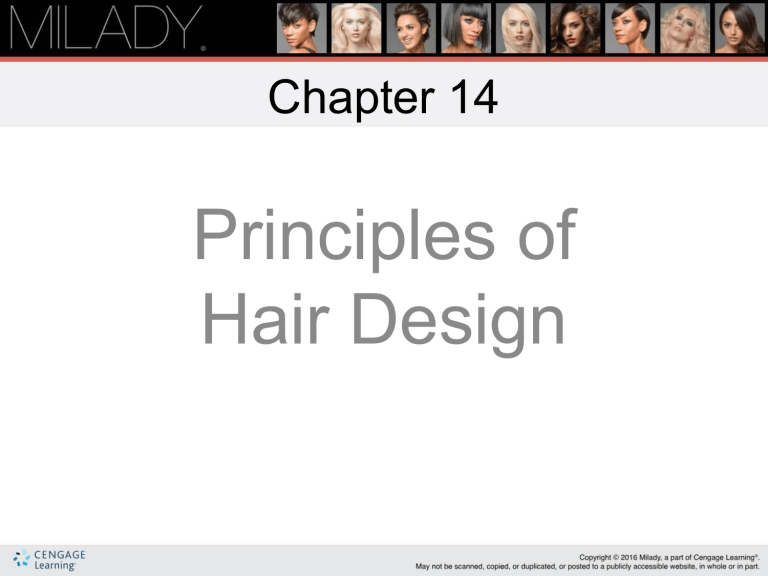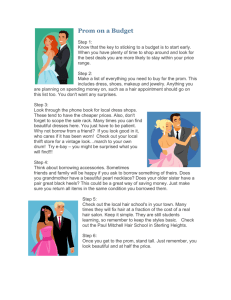Ch 14

Chapter 14
Principles of
Hair Design
Learning Objectives
• Describe sources of hair design inspiration.
• List the five elements of hair design and how they relate to hairstyling.
• Explain the five principles of hair design and recognize their specific contribution to a hairstyle.
(continues)
Learning Objectives
(continued)
• Understand the influence of hair type and texture on design.
• Identify the seven different facial shapes and design a beneficial hairstyle for each.
• Explain two design considerations for men.
Introduction
• To add value to your career as a stylist, take the time to learn how to design the best hairstyle for your client.
• That process begins with analyzing the entire person by using the elements and principles of design to enhance positive features and minimize more challenging ones.
• An understanding of design and art principles will help you develop the artistic skill and judgment needed to create the best possible design for your client.
Discover the Philosophy of Design
• Have a vision.
• Follow a plan.
• Work at the plan.
• Try and try again.
• Take calculated risks.
(continues)
Define the Elements of Hair Design
• Line
• Form
• Space
• Design texture
• Haircolor
Horizontal
Line
Vertical
(continues)
Diagonal
Line
(continued)
Curved
Single line
Designing with Lines
Parallel lines
(continues)
Designing with Lines
(continued)
• Contrasting lines
• Transitional lines
• Directional lines
Form and Space
• Form – outline or silhouette of the style.
• Space – area surrounding the form or area the hairstyle occupies.
• Styling tools
• Chemicals
Design Texture
(continues)
Design Texture
(continued)
• Multiple directional wave pattern combinations: trendy multi-textured look with volume and unconstructed lines
• Smooth patterns: accent the face
• Curly patterns: take attention away from the face
Dimension with color
Haircolor
Lines with color
(continues)
Haircolor
(continued)
Hair Color Selection
• Create a visual plan for placement and patterns of your color choices.
• Consider how each color weighs with the other variables.
• Consult with your client about their color objectives and/or what look or impact is he or she is trying to achieve.
Understand the Principles of Hair Design
• Proportion
• Balance
• Rhythm
• Emphasis
• Harmony
Proportion
• Proportion: the comparative relationship of one thing to another.
– Body proportion: hair and body proportion must be compatible.
• Symmetrical
• Asymmetrical
Balance
Rhythm
• The regular, recurrent pattern of movement in a style
• Wave patterns
Emphasis
• Change in form
• Color • Ornamentation
Harmony
• The most important principle in hair design
• The orderly and pleasing arrangement of shapes and lines.
– Form with interesting lines
– Pleasing color and textures
– Balance and rhythm that together strengthen design
Physical Characteristics
• Shape of the head
• Length of neck
• Facial features
• Body shape and posture
Recognize the Influence of Hair Type and
Texture on Hairstyle
• Straight, fine hair – no body or volume
• Straight, medium hair – more versatility in styling
• Straight, coarse hair – hard to curl and carries more volume
(continues)
Recognize the Influence of Hair Type and
Texture on Hairstyle
(continued)
• Wavy, fine hair – looks fuller with layering
• Wavy, medium hair – offers most versatility
• Wavy, coarse hair – can appear unruly if not shaped properly
(continues)
Recognize the Influence of Hair Type and
Texture on Hairstyle
(continued)
• Curly, fine hair – responds well to mild relaxers
• Curly, medium hair – creates a wide silhouette
• Curly, coarse hair – needs heavy styling products
(continues)
Recognize the Influence of Hair Type and
Texture on Hairstyle
(continued)
• Very curly, fine hair – best cut short
• Extremely curly, medium hair – chemical relaxers and hair pressing are good options
• Extremely curly, coarse hair – chemical relaxing recommended with other thermal services
Create Harmony between Hairstyle and
• Oval
Facial Structure
• Square
• Round
• Triangular
Basic Facial Shapes
• Diamond
• Oblong • Inverted triangle
• Straight profile
Profile
• Convex profile
• Concave profile
Special Considerations: Top Third of Face
• Wide forehead • Receding forehead
• Narrow forehead • Large forehead
Middle Third of Face
• Close-set eyes • Crooked nose
• Wide-set eyes • Wide, flat nose
(continues)
Middle Third of Face
(continued)
• Long, narrow nose • Prominent nose
• Small nose
• Round jaw
Lower Third of Face
• Long jaw
• Square jaw
(continues)
Lower Third of Face
(continued)
• Receding chin • Large chin
• Small chin
Styling for People who Wear Glasses
• Consider eyeglass arms.
• Consider hair length around ear.
Hair Partings: Partings for Bang (Fringe)
• Triangular • Curved
• Diagonal
• Center
Style Parts
• Diagonal
• Side
• Zigzag
Design for Men
• Styles
• Choosing facial hair design
Summary and Review
Of vital importance to the professional cosmetologist is the ability to select, adapt, and execute a hairstyle that is both suitable and desirable to the client.
You will apply the elements and principles of design learned in this lesson to add creativity, dimension, and uniqueness to your work.
Form, space, line, color, and wave patterns are all essential elements in creating a successful style.
(continues)
Summary and Review
(continued)
We have also learned that proportion, balance, rhythm, emphasis, and harmony are used to create total looks that are pleasing to the eye.
It is essential for the successful cosmetologist to be able to analyze the client’s face and head shape when designing a suitable style that will flatter and satisfy the client.
Chapter Review Questions
1. What are possible sources a hair designer might use for inspiration?
2. List the five elements of hair design and give a brief definition of each.
(continues)
Chapter Review Questions
(continued)
3. List the five principles of hair design and describe one form that uses each principle.
4. What influence does hair type and texture have on hairstyle?
(continues)
Chapter Review Questions
(continued)
5. List and describe the seven facial shapes and explain how hair design can be used to highlight or camouflage facial features.
Chapter Review Questions (continued)
6. How do the elements and principles of hair design apply to men?






